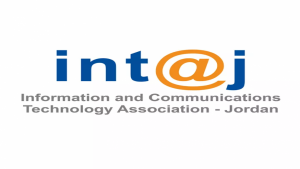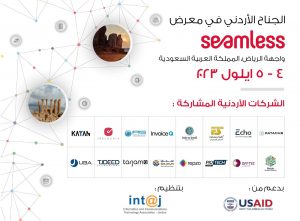


القائم بأعمال السفارة الأردنية في السعودية الوزير المفوض السيدة شفا العموش تفتتح أعمال الجناح الاردني في مؤتمر سيملس السعودية والذي نظمته جمعية انتاج بمشاركة ١٦ شركة أردنية وبدعم من مشروع نمو الاعمال _ USAID



القائم بأعمال السفارة الأردنية في السعودية الوزير المفوض السيدة شفا العموش تفتتح أعمال الجناح الاردني في مؤتمر سيملس السعودية والذي نظمته جمعية انتاج بمشاركة ١٦ شركة أردنية وبدعم من مشروع نمو الاعمال _ USAID

ومع ذلك، لا يكمن التركيز هنا فقط على الأرقام – إنّما يتعلّق الأمر بالاستفادة من مزايا كلّ بلد لتعزيز التعاون، فالاقتصاد السعوديّ ليس مبيّناً على النفط وحده، إذ لديه قطاع تكنولوجيا المعلومات والاتّصالات القويّ أيضاً، حيث تعتبر التكنولوجيا جزءاً أساسيّاً من خطّة السعوديّة الطموحة “رؤية 2030″، الّتي ترسم مساراً لنموّها.

In an age where technology knows no borders, collaborations between nations assume greater significance”. The continuous partnership between Saudi Arabia and Jordan in the field of Information and Communication Technology is an inspiration of innovation, economic growth and mutual development. Complementing each other in this domain brings together the strengths of two distinct nations, creating a synergy that promises to shape a brighter future for both countries and the entire region.
Covering over 2 million square kilometres and housing a population of 36 million, Saudi Arabia is a global economic powerhouse. Its GDP of over $1 trillion underscores its financial clout. In contrast, Jordan, with an area of 89,342 square kilometres and a population of 10.5 million, boasts an annual GDP of $47.5 billion. However, the focus here isn’t just on numbers – it’s about leveraging each country’s unique attributes to foster collaboration.
Saudi Arabia’s economic power is not its only strength, it also has a robust ICT sector. With a high GDP per capita, technology is integral to the country’s ambitious Vision 2030 plan, which charts a course for its growth. This commitment is evident in Saudi Arabia’s claim to the largest ICT market in the Middle East and North Africa, valued at over $32.1 billion. This sector’s vibrancy sets the stage for far-reaching advancements across various industries. On the other hand, Jordan possesses an ecosystem that nurtures innovation. Access to over 160 countries through Free Trade Agreements and bilateral agreements positions Jordan as a gateway to the world.
The rapid expansion of Jordan’s ICT sector, coupled with incentives like favourable tax rates and subsidised salaries, makes it a hotbed for investors seeking a nurturing environment. The strength of this partnership lies in its potential for cooperation. By participating in relevant events within each other’s borders, Saudi Arabia and Jordan are paving the way for shared learning, innovation and prosperity.
Co-organising events would also lead to a positive impact for both countries. The outcomes of this partnership are not confined to Saudi Arabia and Jordan alone. As both nations invest in technology, innovation, and entrepreneurship, they create a ripple effect throughout the region. The positive impact goes beyond economic growth, as it fosters greater understanding, cross-cultural collaboration and technological advancements that benefit the entire region. This collaboration aligns with Saudi Arabia’s Vision 2030 and Jordan’s Economic Modernisation Vision, both of which focus on sustainable development and innovation.
By pooling their resources and expertise, these nations are forging a path towards a brighter and more technologically advanced future. As Saudi Arabia and Jordan walk hand in hand towards their shared vision, they underscore the power of collaboration. Their journey highlights the positive impact of participating in each other’s events, co-organising initiatives and events, and aligning their technological goals.
Through unity and innovation, these two nations are not only securing their own futures but contributing to the advancement of the entire Arab world and beyond.
The writer is the Chief Executive Officer of the ICT Association of Jordan – int@

بلغ عدد الشركات المستفيدة من مشروع إدارة التنوع الاجتماعي 20 شركة تعمل في قطاع تكنولوجيا المعلومات، بحسب رئيسة وحدة تمكين المرأة في جمعية شركات تقنية المعلومات والاتصالات “إنتاج”، زين عصفور.
وقالت عصفور إن المشروع بالشراكة مع مشروع تشجيع المؤسسات الميكروية والصغيرة والمتوسطة لأجل التشغيل، المنفذ من قبل الوكالة الألمانية للتعاون الدولي بالنيابة عن الوزارة الألمانية الاتحادية للتعاون الاقتصادي والتنمية.
وبينت أن المشروع يهدف إلى تعزيز دور المرأة في سوق العمل والأدوار القيادية، وتمكينها لتوسيع نطاق توظيف وترقية النساء، خصوصًا عندما يكون الحديث عن القطاعات الفنية والإدارية.
وأوضحت أن المشروع يركز على توفير التدريب والتوجيه والتقييم للشركات مع توفير الدعم الفني لتنفيذ خطة العمل المقترحة والتركيز على تمكين المرأة والعمل نحو زيادة مشاركتها في القطاع، والتي تبلغ حاليًا حوالي ثلث الوظائف.
ولفتت إلى أن المشروع يعزز من قدرة الشركات على اكتساب عملاء جدد وجذب مواهب أفضل، بحيث تصبح تلك الشركات أكثر إنتاجية وتنافسية على المستويين المحلي والعالمي.



A study conducted by McKinsey revealed that 69 per cent of digital transformation projects fail. Despite this high failure rate, organisations, whether governmental or private sector, continue to invest in these projects due to their utmost importance.
Focusing on these issues and reasons will help us understand why such a significant number of projects fail and provide insights to clients and vendors on overcoming these challenges
The most prominent reasons behind the failure of digital transformation projects include:
Insufficiently defined project goals coupled with poor communication and lack of alignment in expectations. Clients and vendors often initiate projects without a shared vision or a detailed scope encompassing business, operational and technological aspects.
Coordination and alignment of the engaged human resources are crucial. Inconsistencies or disharmony can lead to misunderstandings and misinterpretations during project execution.
Sudden and unexpected changes or modifications in the project scope can cause chaos in project schedules and budgets, leading to frustration among all stakeholders.
The absence of clear project requirements can create a fertile ground for ambiguity, fostering incorrect and conflicting interpretations. This exacerbates challenges related to trust and accountability, hindering progress and achievement.
Failure to involve all members of the organisation and neglecting capacity-building contribute to the delaying of many projects before completion.
Additionally, the complex collaboration methodoligies between clients and vendors, coupled with the issues arising during execution, can hamper the project’s progress.
For clients, transparency, coordination and open communication are essential. Regular communication with vendors ensures alignment throughout the project lifecycle.
Precision and flexibility are also vital in delineating the project scope. Detailing the project comprehensively while maintaining suitable flexibility for potential changes through open discussions with vendors results in better understanding of the impact of any scope modifications.
Close collaboration with product and project managers who comprehend business needs and technical details, along with documenting project specifications and requirements before and during implementation, greatly prevents misunderstandings or disputes between clients and vendors. This builds trust among all parties and team members. Trust in the chosen vendors’ expertise is crucial to harness updates and feedback.
Appointing proficient project and product managers is equally vital for clients’ success. They act as a vital link between clients and vendors, overseeing timelines, budgets and resource allocation, ensuring smooth communication and timely problem resolution.
Equally important, skilled product managers significantly bridge the gap between clients’ business requirements and the technical aspects of the project. Their profound understanding of market trends, user needs, and industry standards translates business goals into technical specifications, aligning with the client’s vision.
Their collaboration with all parties constitutes a robust leadership framework. While project managers ensure efficient execution, product managers guarantee alignment with strategic objectives. This leadership harmony enhances project coordination, reduces misunderstanding and improves outcomes.
As for vendors, effective communication with clients is crucial. Keeping clients informed about project progress, potential challenges and encouraging them to share their ideas, concerns, suggestions and preferences throughout the project lifecycle is essential. Continuously monitoring scope changes and discussing modifications with clients leads to clear insights into the potential impacts of requested changes, fostering a seamless journey built on trust throughout all project phases.
In conclusion, the substantial cost of failure in digital transformation projects can lead to disappointment for both clients and vendors. Nevertheless, understanding the challenges and opportunities in client-vendor relationships can elevate the chances of success for both parties’ projects.
In light of this, I invite clients and vendors to collaborate more effectively. Through joint efforts, knowledge sharing, and transparency, all can create a more successful future for the transformation to a digital economy.
The writer is the Chief Executive Officer of the ICT Association of Jordan – int@j



كشفت دراسة أجرتها شركة “ماكنزي” أنّ 69% من مشاريع التحوّل الرقميّ تفشل، وعلى الرغم من هذه النسبة العالية للفشل، إلّا أنّ المؤسّسات، سواء كانت حكوميّة أو قطاعاً خاصّاً، لا تزال تستثمر في هذه المشاريع؛ لأنّها مهمّة للغاية.
إنّ تسليط المزيد من الضوء على هذه المشاكل والأسباب سيساعدنا على معرفة سبب فشل العدد الكبير من المشاريع وتقديم نصائح للعملاء والمورّدين لتجاوز هذه التحدّيات.
إن من أهم أسباب فشل مشاريع التحول الرقمي والتكنولوجيا:
– عدم تحديد أهداف كافية للمشروع يضاف إليها قلّة التواصل وعدم التوافق في التوقّعات، فقد يبدأ العملاء والمورّدون العمل في المشاريع دون الاتفاق مسبقا على رؤية مشتركة ودون وجود نطاق عمل مفصّل يحتوي على الأمور المتعلّقة بالأعمال والعمليّات والتقنيّات.
– أضف إلى ذلك أهمية العمل على التنسيق والتوافق بين الموارد البشريّة المنخرطة بالمشروع بشكل مباشر أو غير مباشر، إذ يشكل عدم توافقها أو انسجامها إلى سوء فهم او تقدير أثناء مرحلة تنفيذ المشروع.
– كما يمكن للتغييرات او التعديلات المفاجئة وغير المتوقّعة على نطاق المشروع ان تتسبب في إحداث فوضى في جداول المشاريع والميزانيّات، ممّا يؤدي إلى شعور بالإحباط لدى جميع الأطراف المعنيّة بالمشروع.
– إن عدم وجود تعريفات واضحة لمتطلّبات المشروع يمكن أن يوفر أرضيّة خصبة للغموض ويقودنا في كثير من الأحيان إلى تفسيرات خاطئة ومتضاربة، الأمر الذي يرفع من مستوى التحديات لظهور إشكالات تتعلق بالثقة والمساءلة، مما يؤدّي إلى تعطّل التقدّم والإنجاز.
– إن عدم إشراك جميع الأفراد في المؤسّسة بالإضافة إلى عدم الاستثمار في بناء القدرات، يساهم في تعثّر العديد من هذه المشاريع قبل اكتمالها.
– كما تلعب المنهجية أو اللامنهجية – في بعض الأحيان – المعقّدة الّتي يتعاون بها العملاء والمورّدون معاً دورا في تعثر المشروع، جنباً إلى جنب مع المشاكل الّتي تنشأ خلال مرحلة التنفيذ.
أما فيما يتعلق بالعملاء، فلا بدّ من الشفّافيّة والتنسيق والتواصل من خلال محادثات مفتوحة، توضّح أهداف المشروع والتوقّعات والنتائج المطلوبة، فالتواصل المنتظم مع المورّدين يضمن التوافق طوال دورة حياة المشروع.
كما أنّ الدقة والمرونة مطلوبة هنا أيضا في تحديد نطاق العمل من خلال وضع تفاصيل المشروع بشكل شامل وواضح مع الحفاظ على مرونة مناسبة لأي تغييرات محتملة من خلال المشاركة في مناقشات مفتوحة مع المورّدين الأمر الذي سيؤدّي إلى توافق وفهم أثر أيّ تعديلات على نطاق العمل.
إنّ التعاون عن كثب مع مديري المنتجات والمشاريع الّذين يفهمون احتياجات الأعمال والتفاصيل التقنيّة وتوثيق تفاصيل المشاريع قبل البدء بها وخلالها تساهم بشكل كبير في تفادي أيّ سوء تفاهم أو خلافات بين العملاء والمورّدين، بل يساهم أيضاً في بناء الثقة بين جميع الأطراف وأعضاء فرق العمل، فالثقة بخبرة المورد الّذي تمّ اختياره ضروريّة للاستفادة من التحديثات والملاحظات الّتي يتقدّم بها.
كما أن قيام العملاء بتعيين مدراء مشاريع ومنتجات على قدر كبير من الكفاءة يعد واحدا من أهم أسباب نجاح المشاريع، إذ انهم يشكلون حلقة وصل بين العملاء والمورّدين، من حيث الاشراف على الجداول الزمنيّة والميزانيّات وتخصيص الموارد لأنّ قيادتهم وادارتهم للمشروع تضمن التواصل السلس وحلّ المشكلات في الوقت المناسب.
على نفس القدر من الأهمّيّة، فإنّ مدراء المنتجات الماهرين يساهمون بشكل رئيسيّ في ردم الفجوة بين متطلّبات العملاء التجاريّة وجوانب المشروع التقنيّة، لتمتعهم بفهم عميق لاتّجاهات السوق واحتياجات المستخدمين ومعايير الصناعة؛ ممّا يقودنا إلى ترجمة أهداف ومتطلّبات الأعمال التجاريّة إلى مواصفات تقنيّة، الأمر الذي يحقق التوافق مع رؤية العميل.
كما يشكل تعاونهم مع كافّة الأطراف، إطاراً قويّاً للقيادة حيث يضمن مديرو المشاريع تنفيذاً فعّالاً، في الوقت الذي يضمن فيه مديرو المنتجات التوافق مع الأهداف الاستراتيجيّة. هذا التناغم في القيادة يعزّز من عمليات التنسيق في المشروع، ويقلّل من سوء الفهم، ويحسن النتائج.
أما الشق المتعلق بالمورّدين، فلا بدّ لهم من التواصل الفعّال مع عملائهم، من خلال اطلاعهم على تقدّم المشاريع والتحدّيات المحتملة وتشجيعهم على مشاركة أفكارهم، ومخاوفهم واقتراحاتهم وتفضيلاتهم طوال دورة حياة المشروع. كما أنّ الاستمرار في متابعة أيّ تغييرات على نطاق العمل ومناقشة أيّ تعديلات مع العملاء يوصلنا إلى تشكيل رؤى واضحة تبيّن الآثار المحتملة لأيّ تعديلات قد يطلبها العميل مما يؤدّي إلى رحلة سلسة مبنيّة على الثقة خلال كافة مراحل تنفيذ المشروع الذي يتطلب تعاوناً بشكل تشاركيّ مع مدراء المشاريع والمنتجات والعملاء للوصول إلى فهم مشترك لكافة مراحل المشروع.
في الختام، يجدر بنا التشديد على الكلفة الباهظة الثمن الناتجة عن فشل مشاريع التحوّل الرقميّ والتكنولوجيا، والتي تؤدّي إلى إحباط العملاء والمورّدين على حدّ سواء.
ومع ذلك، من خلال فهم جيد لكافة التحدّيات والفرص في علاقات العميل والمورد، يمكن للطرفين زيادة نسبة فرص النجاح لمشاريعهما.
لكل ما تقدم، فإننا ندعو كلّاً من العملاء والمورّدين للتعاون والتنسيق بشكل أكثر فعّاليّة، فالعمل المشترك ومشاركة المعرفة والشفافية، تمكننا من التحول إلى إقتصاد رقمي.
*الرئيس التنفيذي
جمعية شركات تقنية المعلومات والاتصالات – انتاج